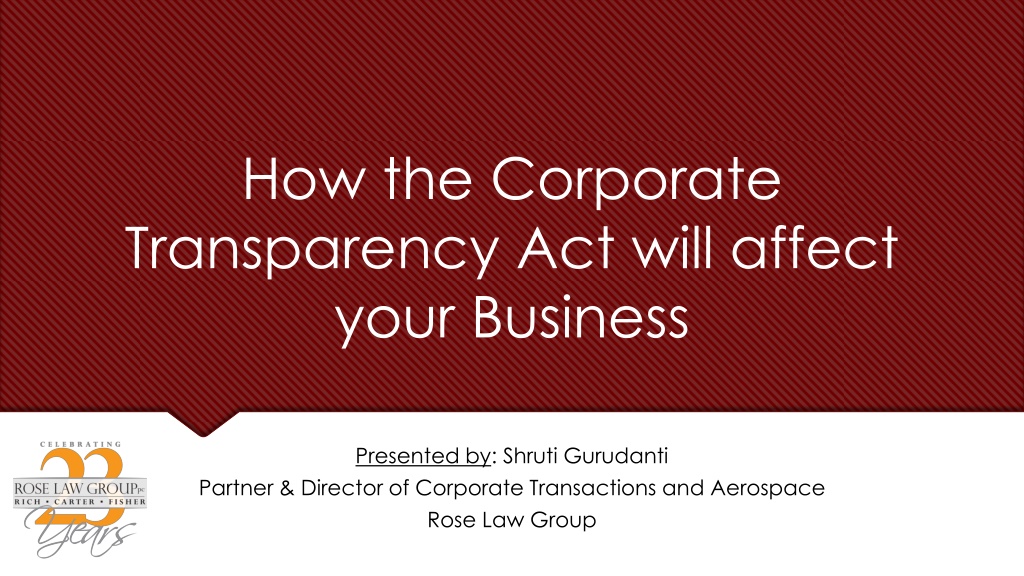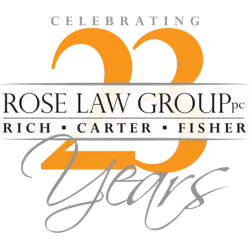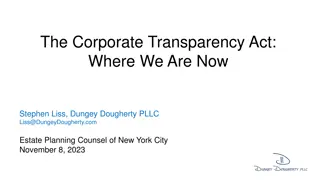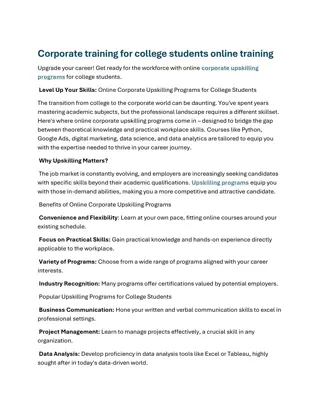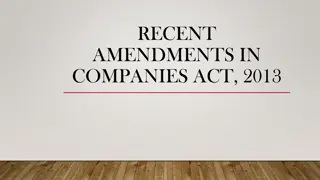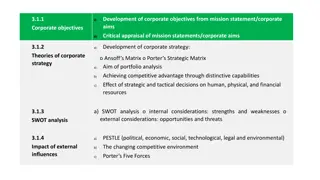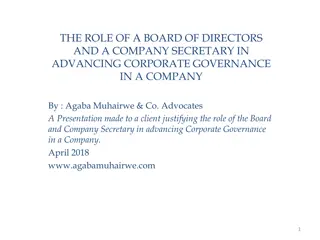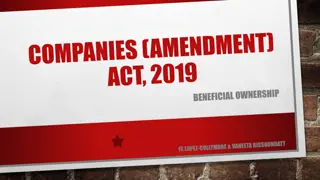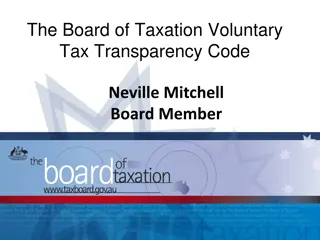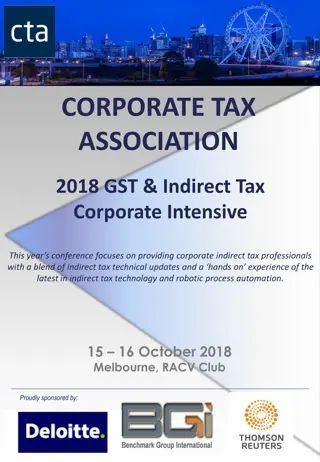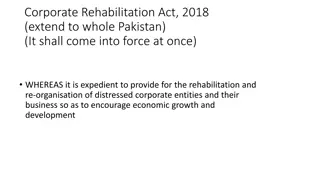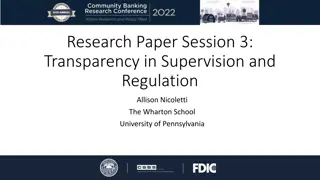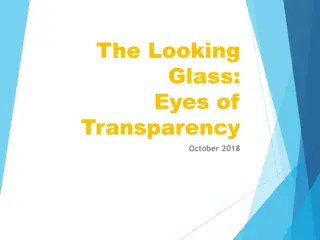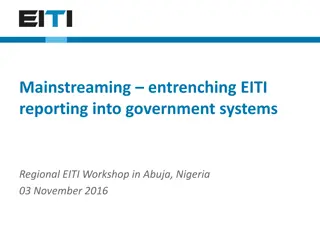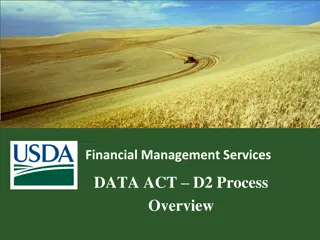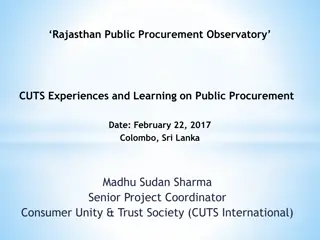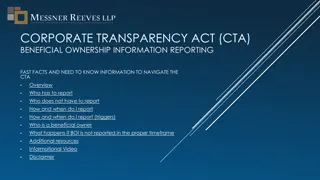Impact of Corporate Transparency Act on Businesses
The Corporate Transparency Act (CTA), part of the Anti-Money Laundering Act of 2020, aims to prevent money laundering and other illegal activities by disclosing beneficial owners of US entities. The act mandates reporting companies to provide ownership information to the US Treasury's FinCEN. Exemptions exist for certain entities. Large operating companies meeting specific criteria are also exempt. Understanding who must file and what information is required is crucial to comply with the CTA and avoid penalties.
Download Presentation

Please find below an Image/Link to download the presentation.
The content on the website is provided AS IS for your information and personal use only. It may not be sold, licensed, or shared on other websites without obtaining consent from the author.If you encounter any issues during the download, it is possible that the publisher has removed the file from their server.
You are allowed to download the files provided on this website for personal or commercial use, subject to the condition that they are used lawfully. All files are the property of their respective owners.
The content on the website is provided AS IS for your information and personal use only. It may not be sold, licensed, or shared on other websites without obtaining consent from the author.
E N D
Presentation Transcript
How the Corporate Transparency Act will affect your Business Presented by: Shruti Gurudanti Partner & Director of Corporate Transactions and Aerospace Rose Law Group
Background Anti-Money Laundering Act of 2020 (AMLA) was introduced to update the anti-money laundering laws in the US. The Corporate Transparency Act (CTA) is the most notable addition. Purpose is to stop bad actors from concealing their ownership of US entities, which are used to facilitate money laundering, terrorism, tax fraud, and other illegal acts. Through the CTA, Congress directs the US Treasury Department s Financial Crimes Enforcement Network (FinCEN) to establish and maintain a national registry of beneficial owners of entities that are deemed Reporting Companies. Anti-Money Laundering Act of 2020 (AMLA) was introduced to update the anti-money laundering laws in the US. The Corporate Transparency Act (CTA) is the most notable addition. Purpose is to stop bad actors from concealing their ownership of US entities, which are used to facilitate money laundering, terrorism, tax fraud, and other illegal acts. Through the CTA, Congress directs the US Treasury Department s Financial Crimes Enforcement Network (FinCEN) to establish and maintain a national registry of beneficial owners of entities that are deemed Reporting Companies.
General Overview 1. Who must file? 2. When must an entity file? 3. What information is required? 4. What are the penalties?
Reporting Companies All Reporting Companies , unless an exemption applies. Domestic Reporting Company: any corporation, LLC, LPs or other entity created by filing a document with the secretary of state or similar office in any state or territory or with a federally recognized Indian Tribe (NOT general partnerships and certain estate planning trusts). Foreign Reporting Company: any corporation, LLC or other similar entity formed under the laws of a foreign country and registered to do business in the United States.
Exempt Entities SEC-reporting companies (public companies, registered broker-dealers, registered investment companies or investment advisor, Venture capital fund advisers) Insurance companies Tax-exempt entities e.g., 501c3 Large operating companies Accounting Firms Inactive entities Banks and Credit Unions *wholly-owned or controlled subsidiaries of certain exempt entities.
Exempt Entities: Large Operating Company 1. Entity that employs more than 20 FT employees in the US; 2. Has filed a federal US income tax return for the year prior showing more than $5 million in gross receipts or sales (not including receipts and sales from sources outside of the US), and 3. Operates from physical office premises in the US. (All three required) *Entity itself has more than 20 FT employees. Not pooling other subsidiaries. ** Entity that initially qualifies as a large operating company but later fails to qualify will need to file a BOI Report. Conversely, an entity that initially is a Reporting Company but then becomes exempt, must file an update noting such change.
Exempt Entities: Inactive Entities 1. In existence prior to Jan. 1, 2020 2. Is not engaged in active business 3. Is not owned by a foreign person (directly or indirectly) 4. Does not hold any assets 5. In the last 12 months, has not seen a change in ownership 6. In the last 12 months, has not received or sent funds more than $1,000 (All six are required) *An entity that holds ownership interest in another entity is NOT an inactive entity .
Exempt Entities: Subsidiary 1. Subs that are controlled or wholly owned , directly or indirectly, by an exempt entity. 2. Example: 100% sub of a large operating company is exempt. To qualify, the sub s ownership must be fully, 100% owned or controlled (not partially) by an exempt entity. 3. Control means the exempt entity entirely controls all the ownership in the reporting company, in the same way that an exempt entity must wholly own all the sub s ownership for the exemption to apply. 4. Exemption does NOT extend to subsidiaries of: (a) money services business, (b) pooled investment vehicles, or (c) entities assisting a tax-exempt entity. *An entity that holds ownership interest in another entity is NOT an inactive entity .
When to File? Before January 1, 2024 Due no later than January 1, 2025. One-time report (not annual) The due date for the initial report depends on when the entity was created B/w Jan. 1, 2024 & Dec. 31, 2024 Due within 90 days from formation Within 30 days from the date of change (Stay on top of these changes! Include obligations within your operating agreement/bylaws) Post Jan 1, 2025 Within 30 days from formation
Information to Report Reports include information about: 1. The Reporting Company; 2. The Reporting Company s beneficial owners (BO); and 3. Company applicants (CA) who made the filings to create the entity (only for entities formed after 2024).
Information on the Reporting Company 1. Full legal name 2. Any trade name or doing business as (d/b/a) name 3. Current address 4. Jurisdiction of formation 5. Federal taxpayer ID number
Information on (each) BO & CA Full legal name Date of birth Current address (residential for BO / Company for CA) Unique identifying number and issuing jurisdiction (e.g., U.S. passport or driver license) Image of document with identifying number 1. 2. 3. 4. 5. * FinCEN Identifier: individuals & entities may apply for and obtain a FinCEN identifier, which can be included on filings in lieu of this information.
Beneficial Owner Beneficialowner of a Reporting Company is any individual who, directly or indirectly: Exercises substantial control over the Reporting Company OR Owns or controls 25%+ of ownership in the Reporting Company.
Substantial Control An individual exercises substantialcontrol over a Reporting Company if the individual: Serves as a senior officer (e.g., CEO, CFO, President, COO, Manager) Has authority to appoint or remove any senior officer or a majority of the board; Directs, determines, or has substantial influence over important decisions made by the Reporting Company (nature & scope of business, transfer of assets, reorganization, dissolution, major expenditures & investments, compensation of senior officers, and significant contracts); OR Has any other form of substantial control over the Reporting Company (catch- all provision) 1. 2. 3. 4.
Substantial Control Individuals with control over the Reporting Company are BeneficialOwners , even if they have no ownership interests. Exercise of substantialcontrol can be direct or indirect including as a trustee of a trust or similar arrangement, board representation, management contracts, rights associated with financing arrangements, or control over intermediary entities that exercise substantial control.
How is Ownership Interest defined & calculated?
Ownership Interests Equity, stock, or similar instrument Capital or profit interest in an entity Convertible instruments Put, call, straddle, or other options Any other instrument, understanding, relationship, or other mechanism used to establish ownership (catch-all provision) contract, arrangement,
Ownership Interests Ownership or Control of ownership interests may be direct or indirect: Actual ownership Through other individuals acting as a nominee, intermediary, custodian, or agent on behalf of such individual As party to a trust Through ownership or control of intermediary entities, which then owned or control ownership interests in a Reporting Company Through any contract, arrangement, understanding, relationship, or otherwise (catch-all provision) 1. 2. 3. 4. 5.
Calculations of Ownership Interests Ownership interests of the individual is calculated at the present time, and any options or similar interests are treated as exercised. Profits/Capital Interests: Individual's capital and profit interests in Reporting Company is calculated as a percentage of the total outstanding capital and profit interests of the Reporting Company. Corporations: Percentage is calculated as the greater of: Individual s total combined voting power as a percentage of outstanding voting power of all classes; or Individual s total combined value of ownership interests as a percentage of total outstanding value of all classes of ownership interests.
Are there any exemptions to the definition of Beneficial Owners ?
Beneficial Owner Exemptions Minor children. An individual acting as a nominee, intermediary, custodian, or agent on behalf of another individual (in which case that individual would be the beneficial owner). An employee of the Reporting Company, acting solely as an employee, whose substantial control over or economic benefits from the entity are derived solely from the employment status (provided that the person is not a senior officer of the entity). An individual whose only interest in a Reporting Company is a future interest through a right of inheritance. A creditor of the Reporting Company.
Company Applicant CompanyApplicant is one of two people: 1. The individual who directly files the document that creates the Reporting Company; OR 2. The individual who is primarily responsible for directing or controlling the filing of the Reporting Company. Typically, the company applicant may also be a beneficial owner of the company. *Attorneys & paralegals may be considered companyapplicants if they file corporate formation documents on behalf of clients. ** Entities created prior to January 1, 2024, do not need to include information on company applicants.
Once an initial report is filed, does it need to be updated?
Updated Reporting Yes! An updated report must be filed within 30 calendar days after the change occurs. Examples of changes that would require an updated report include: 1. Changes in who is a beneficial owner, e.g., due to transfers of ownership or death 2. Reporting Company becomes exempt from the reporting requirements 3. Transfers of ownership when a minor child reaches the age of majority 4. Changes to an identifying document previously submitted, e.g., changes in address
Penalties * Individual liability for any person who causes failure or is a senior officer at the time of failure Failing to comply; OR Willfully providing false or fraudulent reports ** Safe harbor from such civil and criminal liability for the submission of inaccurate information if the person who submitted the report voluntarily corrects the report within 90 days. Civil fines of $500 a day for as long as the reports remain inaccurate. and promptly Failure to comply may also subject the violators to the criminal penalties of a $10,000 fine or 2 years in jail.
Who can access the information once the report is filed?
Access to Reported Information Reports filed with FinCEN will not be accessible to the public and are not subject to requests under the Freedom of Information Act. The following government agencies will have access to the information upon requests: Federal law enforcement agencies (national security, intelligence, & civil and criminal enforcement) Treasury Department State, local or tribal law enforcement agencies (if authorized by a court order) Financial institutions for customer due diligence purposes, if authorized by the Reporting Company 1. 2. 3. 4.
Next Steps Reports will be submitted via electronic reporting system that is currently available. Start to identify individuals who qualify as beneficialowners and companyapplicants in order to meet the reporting deadlines. Keep in mind: Any future changes to BO / CA will also need to be reported to FinCEN. Disclaimer: This presentation is for information purposes only and does not constitute legal advice. Please consult with your legal counsel regarding your specific circumstances to determine what (if any) rights and obligations you may have in connection with the Corporate Transparency Act.
THANK YOU! Shruti Gurudanti Partner & Director of Corporate Transactions & Aerospace sgurudanti@roselawgroup.com
